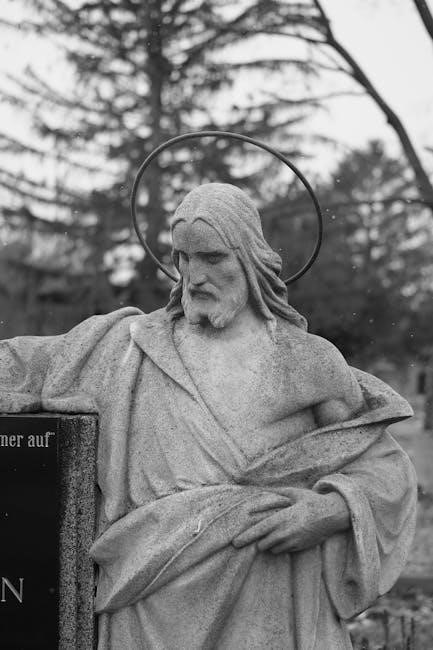Handel’s Messiah: An Overview
Handel’s Messiah, a renowned oratorio composed in 1741, stands as Händel’s most successful work. Its libretto, derived from the King James Bible and the Book of Common Prayer, narrates the life of Jesus Christ.

The Composition of Messiah
Handel composed Messiah in a remarkable burst of creativity in 1741, completing it in just twenty-four days, between August 22nd and September 14th. This period showcases Handel’s exceptional skill and dedication.
Handel’s Inspiration and Timeline
Handel’s inspiration for Messiah emerged during a period of artistic exploration. The oratorio, composed in the summer of 1741, reflects his experimental nature; From August 22nd to September 14th, Handel dedicated himself to this project. The rapid composition of Messiah underscores Handel’s profound musicality and unwavering focus.
The timeline reveals a concentrated period of creative output. This short period highlights Handel’s ability to channel his inspiration. The completed work stands as a testament to his genius, solidifying its enduring legacy. Handel’s commitment to Messiah shaped one of the greatest choral works.
Charles Jennens’ Libretto
Charles Jennens crafted the libretto for Handel’s Messiah, drawing from the King James Bible. Jennens also used the Book of Common Prayer to create the text. His selection of scriptures provides the narrative framework for the oratorio. Jennens’ work traces the life of Jesus Christ, using prophecies and stories.
The libretto’s structure contributes to the thematic depth of Messiah. Jennens carefully curated passages to convey its message; His collaboration with Handel resulted in a powerful and cohesive work. The libretto plays a crucial role in the oratorio’s enduring appeal. Jennens’ contribution remains vital to the success of Messiah.
Sources of the Libretto
The libretto for Handel’s Messiah is primarily sourced from the King James Bible. Selections from the Book of Common Prayer also contribute. These texts provide the foundation for the oratorio’s narrative.
Old Testament Prophecies
The Old Testament prophecies form a crucial part of the libretto for Handel’s Messiah. These prophecies, drawn from books like Isaiah and Malachi, foreshadow the coming of the Messiah. The anticipation for the Messiah is a central theme in Part I of the oratorio. Passages such as “Comfort ye, comfort ye my people” and “Every valley shall be exalted” are prime examples. These verses create a sense of hope and expectation. They describe the glory of the Lord being revealed. The Old Testament selections provide a historical and theological context. They prepare the audience for the arrival of the Messiah, Jesus Christ. These prophecies highlight God’s promises. They demonstrate the fulfillment of these promises in the New Testament narrative.
New Testament Narratives
The New Testament narratives in Handel’s Messiah depict the life, death, and resurrection of Jesus Christ. These narratives follow the prophecies of the Old Testament. They present the fulfillment of those prophecies in the person of Jesus. Key scenes such as the annunciation and the birth of Christ are included. The narratives also cover Jesus’s ministry, his suffering, and his ultimate sacrifice. Passages like “And lo! the angel of the Lord came upon them” are featured. These passages bring the story to life. They emphasize the divine nature of Christ. The New Testament sections of the libretto highlight themes of redemption and salvation. They offer a message of hope and eternal life through faith in Jesus Christ. The narrative is sourced from the New Testament. It offers listeners a profound spiritual experience.

Structure of Messiah
The structure of Messiah unfolds in three parts. Part I focuses on prophecy and incarnation. Part II covers sacrifice and redemption. Part III explores resurrection and eternal life.
Part I: Prophecy and Incarnation
Part I of Handel’s Messiah, often considered the Christmas portion, begins with anticipation for the Messiah, drawing from prophecies in Isaiah and Malachi. Scene 1, “The Coming of the Lord Brings Hope,” features the comforting words “Comfort ye, my people,” promising solace and redemption; This section also includes the declaration “Ev’ry valley shall be exalted” and the revelation of “the glory of the Lord.” The overarching theme emphasizes hope and divine promise. It also addresses the question “But who may abide the day of His coming?”, setting a tone of both expectation and solemnity. The content is sourced from scripture and intended to prepare the listener’s heart.
Part II: Sacrifice and Redemption
Part II of Handel’s Messiah shifts focus to Christ’s suffering, sacrifice, and ultimate redemption of humanity. This segment explores the Passion, death, and ascension of Jesus. Key musical pieces reflect the weight of Christ’s burden and the triumph over sin. The chorus sections often portray the emotional responses of the crowds, ranging from disbelief to acceptance. This part showcases the core Christian doctrine of atonement through Christ’s sacrifice. It highlights the transformative power of redemption and its implications for believers. Through poignant melodies and powerful harmonies, Handel captures the essence of sacrifice and the subsequent promise of salvation.
Part III: Resurrection and Eternal Life
Part III of Handel’s Messiah celebrates Christ’s resurrection and the promise of eternal life. This section is filled with triumphant choruses and uplifting arias that convey hope and victory over death. The music emphasizes the transformative power of Christ’s resurrection, offering believers the assurance of salvation. Themes of immortality and eternal glory are central to this part. The libretto draws from New Testament passages that speak of the afterlife and the reign of God. Handel’s masterful use of musical techniques creates a sense of awe and reverence. Part III serves as a powerful conclusion to the oratorio, reinforcing the central message of faith and redemption.

Availability of the Messiah Score in PDF Format
The Messiah score is available in PDF format from sources like CCARH, offering full scores for study and performance. These editions provide access to this timeless oratorio.
CCARH Edition
The Center for Computer Assisted Research in the Humanities (CCARH) offers a digital edition of Handel’s Messiah in PDF format. This edition, available since 2003 and updated in 2011, provides a full score. It is meticulously prepared, agreeing in its text with a new edition of the full score. This version enables detailed study and performance analysis. The CCARH edition is a valuable resource for musicians. It is available for free online. This resource provides researchers, students, and performers alike with access to a scholarly rendition of Handel’s masterpiece. The digital format ensures accessibility and facilitates in-depth engagement with the oratorio’s intricacies.
Novello Edition
The Novello Edition of Handel’s Messiah is a historically significant publication of the score. It is available as a PDF for download. Known as Novello’s Original Octavo Edition, this version of the sacred oratorio is celebrated for its accuracy. It reflects the composition of 1741. This edition represents a cornerstone for performances. It’s invaluable for scholars. The Novello Edition offers insights into the performance practices of the time. The edition is widely accessible in PDF format. It provides a readily available resource for musicians and researchers alike. Its historical importance and practical usability make it a definitive edition for studying and performing the oratorio.

Key Musical Elements
Handel’s Messiah showcases distinct musical elements, including powerful choruses and memorable arias. The effective use of recitatives to drive the narrative forward are also important.
Use of Choruses
The choruses in Handel’s Messiah are integral to its grandeur and emotional impact. They serve multiple purposes, from proclaiming prophecies and narrating events to offering commentary and expressing collective emotions.
These choral sections are not merely decorative; they are fundamental to the oratorio’s structure, reinforcing the key themes of hope, redemption, and triumph. The powerful “Hallelujah” chorus, perhaps the most famous, exemplifies the celebratory nature of the work.
Other choruses, like “And He shall purify,” showcase the composer’s mastery of counterpoint and harmonic complexity, enriching the overall listening experience and contributing to the Messiah’s enduring legacy. The choruses also add depth, and a collective voice to the message.
Notable Arias and Recitatives
Handel’s Messiah features a collection of arias and recitatives that are essential for conveying the narrative and expressing emotions. The recitatives, such as “Comfort ye, my people,” establish the context and set the stage for the arias that follow.
Arias like “Ev’ry valley shall be exalted” display vocal agility, while others, such as “He was despised,” delve into profound sorrow. These arias bring the characters and prophecies to life, enriching the story.
The careful selection of scriptural texts by Charles Jennens adds to the overall impact of the arias. The combination of musical artistry and narrative depth makes these segments memorable and important. These elements make it a sacred experience.
The Enduring Legacy of Messiah
Handel’s Messiah has left an enduring legacy, establishing itself as one of the most beloved and frequently performed choral works in history; Its themes of hope, redemption, and faith resonate deeply with audiences across generations.
The oratorio’s powerful combination of music and scripture has made it a staple in concert halls, churches, and other venues worldwide. The emotional depth and spiritual significance of Messiah continue to captivate listeners, fostering a sense of community and reflection.
Messiah’s impact extends beyond its musical merit, serving as a symbol of cultural heritage and artistic excellence. Its timeless message and universal appeal ensure its place in music history. It continues inspiring both performers and listeners alike.

Leave a Reply
You must be logged in to post a comment.